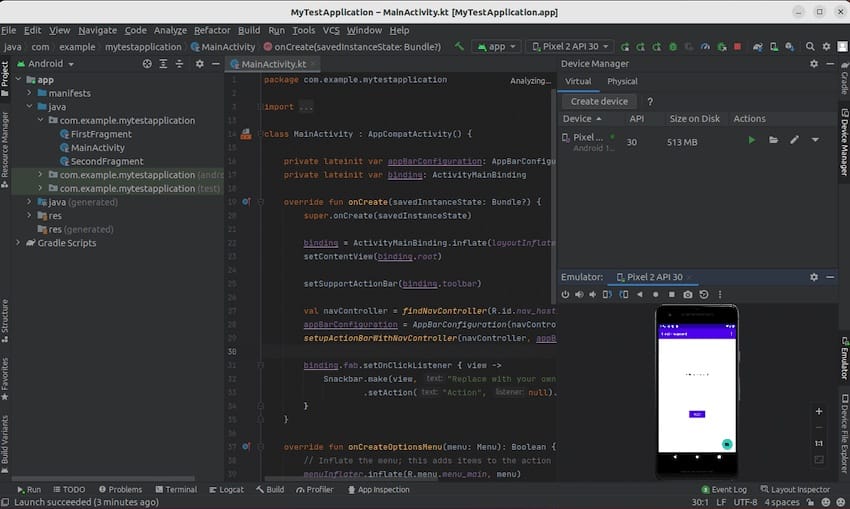How To Install Android Studio on openSUSE

In this tutorial, we will show you how to install Android Studio on openSUSE. Android Studio, the official Integrated Development Environment (IDE) for Android app development, is a powerful tool that offers a complete, integrated environment for creating Android applications. It is designed to accelerate your development and help you build the highest-quality apps for every Android device.
This article assumes you have at least basic knowledge of Linux, know how to use the shell, and most importantly, you host your site on your own VPS. The installation is quite simple and assumes you are running in the root account, if not you may need to add ‘sudo‘ to the commands to get root privileges. I will show you the step-by-step installation of Android Studio on openSUSE.
Prerequisites
- A server running one of the following operating systems: openSUSE.
- It’s recommended that you use a fresh OS install to prevent any potential issues.
- You will need access to the terminal to execute commands. openSUSE provides the Terminal application for this purpose. It can be found in your Applications menu.
- You’ll need an active internet connection to download Kodi and its dependencies.
- You’ll need administrative (root) access or a user account with sudo privileges.
Install Android Studio on openSUSE
Step 1. Before installing any new packages on your openSUSE system, it’s a good practice to update the system packages to the latest versions. This can be done using the following command:
sudo zypper refresh sudo zypper update
This command updates all the packages on your system to their latest versions. If prompted, enter your password and press Y to confirm the update.
Additionally, you’ll need to have the Java Development Kit (JDK) installed on your system. You can install it using OpenSUSE’s package manager, Zypper, with the following command:
sudo zypper install java-11-openjdk-devel
This command installs OpenJDK 11, which is a widely used and fully supported version of JDK.
Step 2. Installing Snap.
Snap is a software packaging and deployment system developed by Canonical for operating systems that use the Linux kernel. The beauty of Snap is that it allows you to install software and all its dependencies in one go, eliminating the hassle of manual installation. To install Snap on openSUSE, open your terminal and enter the following commands:
sudo zypper addrepo --refresh https://download.opensuse.org/repositories/system:/snappy/openSUSE_Leap_15.2 snappy sudo zypper --gpg-auto-import-keys refresh sudo zypper dup --from snappy sudo zypper install snapd
After installation, enable the snapd service with this command:
sudo systemctl enable --now snapd
Step 3. Installing Cockpit on openSUSE.
With Snap installed, you can now install Android Studio. Run the following command in your terminal:
sudo snap install android-studio --classic
Once the installation is complete, you can verify it by running:
android-studio
If Android Studio starts up, you’ve successfully installed it. If not, check the error message in the terminal for clues on what went wrong.

Step 4. Configuring Android Studio.
After installing Android Studio, you’ll need to perform some initial setup. This includes downloading additional SDK components. When you first run Android Studio, it will prompt you to download these components.
Next, you’ll need to set up some environment variables. The ANDROID_HOME environment variable should point to the location of your Android SDK installation. It’s also a good idea to add the Android SDK’s tools and platform-tools directories to your PATH. Here’s how you can do it:
echo 'export ANDROID_HOME=$HOME/Android/Sdk' >> ~/.bashrc echo 'export PATH=$PATH:$ANDROID_HOME/tools' >> ~/.bashrc echo 'export PATH=$PATH:$ANDROID_HOME/platform-tools' >> ~/.bashrc source ~/.bashrc
Step 5. Installing Android Emulator Dependencies.
To use the Android Emulator, you’ll need to install some additional libraries. These can be installed via Zypper:
sudo zypper install libstdc++6:i386 libgcc1:i386 zlib1g:i386 libncurses5:i386
Congratulations! You have successfully installed Android Studio. Thanks for using this tutorial for installing Android Studio on your openSUSE system. For additional or useful information, we recommend you check the official Android Studio website.